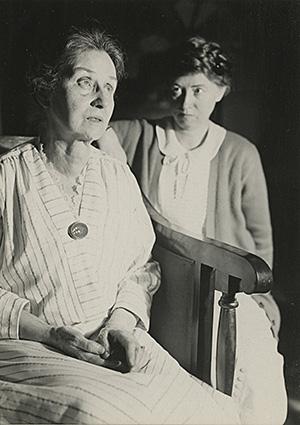Marianne Moore was never so confounding as when she dabbled in simplicity. In The Complete Poems of Marianne Moore, published in 1967, the 80-year-old poet had ruthlessly pared down “Poetry” from 29 lines to three:
I, too, dislike it.
Reading it, however, with a perfect contempt for it, one discovers in
it, after all, a place for the genuine.
Nearly five decades had passed since “Poetry” was first published in 1919, and Moore had revised the poem several times since then—adding, subtracting, doing as she pleased. “Omissions are not accidents,” she declared in a prefatory note to The Complete Poems, leaving some of her most ardent admirers not just flabbergasted but furious. Hilton Kramer, reviewing a new edition of The Collected Poems in 1981, complained of Moore’s “bizarre appetite for unrestrained deletion” and deemed her revised poems “woefully disfigured.” The poem “Poetry,” in particular, “she reduced to a ruin.” Kramer lamented that Moore’s “revisionist impulse” had something to do the “cultural celebrity” she enjoyed (or suffered) late in life. Her career was the “perfect example of the way a poet’s fame may come in time to obscure the essential quality of the poetry upon which it is ostensibly based.” That Moore herself welcomed the public attention, that she in fact “lent herself to its promotion,” is a mystery “for her biographers to explain.”

Photo by Morton D. Zabel, courtesy of the Rosenbach Museum & Library.
Linda Leavell, who has spent the better part of three decades immersed in Moore’s life and work, takes up Kramer’s challenge and more in Holding On Upside Down. (The title is taken from a line in “Poetry”—“the bat/ holding on upside down or in quest of something to/ eat”—among the many that Moore eventually excised.) Moore didn’t leave behind any journals, but Leavell includes details of Moore’s everyday life that give this account a sense of immediacy, even if Leavell’s treatment of the poetry suffers somewhat as a result. “The best record of her inner life, I discovered, was in her poems,” Leavell writes, which she then scours for evidence of what Moore might have been thinking or feeling at a particular time in her life. But full-blown textual analyses would have been out of place in such a readable and intimate biography. Besides, Leavell finds other puzzles elsewhere: How did Moore go from writing Modernist poetry so dense and enigmatic that T.S. Eliot deemed her work “too good … to be appreciated anywhere” to throwing out the first pitch at a Yankees game?
Marianne Craig Moore was born in 1887 in Kirkwood, Mo., the younger of Mary Warner Moore’s two children. Marianne never met her father. Her parents separated shortly before she was born, when he had a nervous breakdown (doctors diagnosed him with “mania on moral and religious matters”), and Marianne wouldn’t even see a picture of him until she was past middle age. After she graduated from Bryn Mawr in 1909, she went to business college; in the summer of 1910 she returned home and lived with her mother until Mary Moore’s death, 37 years later. Her mother’s companion and probable lover, Mary Jackson Norcross, was another source of advice and support. Marianne called her “Rustles,” for the sounds made by her taffeta petticoat, and “Beaver,” because Mary Norcross liked to wear brown.
The only other people in Marianne’s life who merited such affectionate nicknames were her mother and her brother, Warner. Her mother called Marianne “Rat,” or the diminutive “Ratty,” and referred to her as a “he.” Leavell is justifiably reluctant to pass ultimate judgment on Mary Moore’s influence over Marianne, declining to declare her a stifler of creativity, as so many have done, and noting how often Mary enabled her daughter to write, assisting with correspondence as well as with household obligations. Marianne, for her part, never showed an interest in marriage, or even sex, taking Henry James as a model for her own chastity. Nor did she long for children. Babies, she decided, were “repellent larvae.”
More essential to Marianne was poetry, to which she demonstrated her devotion as both a writer and the editor of the legendary Modernist journal The Dial. For four years, until The Dial closed shop in 1929, Moore chose which poets and critics to publish, subjected them to her scrupulous edits (even though she would publicly maintain that it would be a “sacrilege to change or add even a comma”), and encouraged new talents like Hart Crane and Kenneth Burke. (Awaiting Moore’s editorial decision, an anxious Crane grumbled to friends about “the Rt. Rev. Miss Mountjoy” and the “hysterical virgin.”)
Moore had already established herself as a poet in her own right, though her work was only half-understood, even by her most admiring critics. They complimented her poems for their chilly intellect: “Emotion in her,” as one critic put it, “is calcined to a thin ash.” Moore disagreed. However much she valued precision, she also insisted her writing had a real “gusto.” In “When I Buy Pictures,” she described how “too stern an intellectual emphasis upon this quality or that detracts from one’s enjoyment.”
“When I Buy Pictures” is one of Moore’s earlier poems, written long before Moore became America’s public poet, the little old lady in the tricorne hat. Leavell sees a turning point around World War II, just after Moore had tried and failed to sell a novel—“a poet’s novel,” according to one gentle rejection letter—and started submitting her poetry to general-interest magazines like the Atlantic and The New Yorker. Those poems were rejected too. Moore might have been disappointed, but she told her brother that she understood why those magazines declined to publish her work: “Technical virtuosity is not the essential nourishment we need at this time.” She herself started to write poems whose syntax was looser, the symbolism and import more readily apparent. A caged bird, for instance, “though he is captive,/ his mighty singing/ says, satisfaction is a lowly/ thing, how pure a thing is joy.”
Leavell concedes that Moore’s new poems still demanded what Pound called “mental attention,” but “that attention is now rewarded with a meaning closer to what readers expect from poetry.” In 1943 Moore published “In Distrust of Merits,” a war poem whose heightened emotion and sincere use of “O”s garnered both admiration and condemnation. Helen Vendler simply called it a “bad poem” that was “monotonously anthologized because of its concurrence with popular sentiment.” W.H. Auden, however, anointed it “the best of them all” and wrote about Nevertheless, the collection in which “In Distrust of Merits” appeared,” for the New York Times Book Review, confessing the difficulty he had with her earlier work. He wanted to “assure” new readers that they, too, could learn to love her poetry as much as he did. Within three months, Nevertheless went into a third printing. A friend of Moore’s sent her a note detailing the difficulties he had finding copies of her book. “Congratulations on being a best-seller,” he wrote. “After all, it’s one of the goals.”

Photo courtesy Lee Guthrie
If this sentiment makes you shudder with Hilton Kramer–like revulsion, then you might want to cover your eyes for what comes next. Over the next three decades, Moore became famous—mainstream, pop-culture famous—with not only a National Book Award and a Pulitzer but also five-page spread in Sports Illustrated and a photo shoot with Cecil Beaton in Vogue. She started writing poems more quickly—bright, witty poems that were conspicuously removed from the unsettling depths of her earlier work. A pharmaceutical company paid her $500 to write a poem about one of its medicines for a company newsletter. Ladies’ Home Journal published a poem she had written for a Phi Beta Kappa event. Not long before she threw out that first pitch at Yankee Stadium in 1968, she appeared with Dionne Warwick and Sidney Poitier on The Tonight Show. Poitier even read a few lines from “In Distrust of Merits”: “The world’s an orphan’s home. Shall/ we never have peace without sorrow?”
Leavell records all of this with a biographer’s fascination and empathy for her subject, even if she herself seems somewhat alarmed by the promiscuity with which the elderly Marianne disbursed her poetic gifts. But such fame, it must be said, did attract an audience for some of Moore’s more idiosyncratic interests. For years, she had been trying to find a publisher for her translation of La Fontaine’s Fables, which she eventually did, in 1951. When the book was finally published in 1954, Leavell writes, “Moore’s celebrity status created a market for her Fables that no publisher could have imagined when she began the project a decade earlier.” The book went into several printings, and demand stayed strong for years, prompting her publishers to issue a paperback edition in 1964.
Moore’s later poems may not have achieved the kind of compressed intensity of her earlier work, but was this the corrupting influence of fame and fortune? Or was it simply a case of a poet getting older, changing her method and changing her mind? In the end, Leavell herself seems ambivalent; she can’t exactly countenance some of Moore’s more downmarket bids for attention (the poet appeared with Mickey Spillane in Braniff Airways’ “When you got it, flaunt it” campaign), but neither can she bring herself to condemn Moore for deriving a good deal of pleasure from “feeling needed” in her later years. Besides, Leavell notes with some asperity that Moore was soon eclipsed by a younger generation of women poets that included Anne Sexton and Adrienne Rich, which leads Leavell to write, with a straight face, that Moore “deserves to be more widely known.” This line struck me for its mix of honesty and absurdity. Such is the fickle food of fame—always too much and never enough.
—
Holding on Upside Down: The Life and Work of Marianne Moore by Linda Leavell. Farrar, Straus and Giroux.
See all the pieces in this month’s Slate Book Review.
Sign up for the Slate Book Review monthly newsletter.